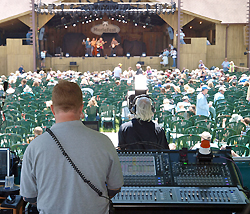
Mitchell, a freelance engineer who’s worked with artists from Umphreys McGee to Mickey Hart and Kitaro also had nothing but raves to impart about his DiGiCo experience.
“In response to the question, ‘what’d you like about the console?’ everybody’s going to say it sounded better and that it was easy to use—those are pretty stock responses,” Mitchell says. “But the thing that impressed me most about this console was I was able to get the guest engineers up to speed—many of which that had little or no digital experience ever.
“The SD10 was very intuitive, and it was nice to be able to say, ‘use the end of your finger, press what you want to see and it’s going to pop up… read what it says and change it accordingly.’ And usually by the second song, they weren’t asking any questions at all.”
“It’s nice to have all the horsepower built in, too,” Mitchell adds. “It’s a very hot rod console. I’ve done lots of shows on Yamaha 5Ds and Avid Profile’s and it’s great to have the multiband parametric and dynamic EQ as part of the package—not as an add-on or an extra—and they sounded great/
“We had a Lake Technology Contour System for the routing and EQ of the main system, not because it was necessary but because it was interfacing with the amplifiers and by default it was there. But we really didn’t need it. There was enough EQ and routing built into the console and that was the only device that we used extensively.”
Both Parker and Mitchell both raved about the onboard presets, as well as the ability to build layers easily.
“Setting up the console pre-event, we had a basic starting festival plot of 44 channels and most of the bands fit into that pretty easy,” Mitchell recalls. “Bluegrass engineers like to set up in a column form, DI-1, Vocal-1, Instrument Mic-1, etc., so I had the main layer set up 1-44 in order, and on the second layer below it I would arrange things in groups of specific instruments or whatever would make it easy pertaining to a particular band.
“Once we went live, it was very intuitive to recall those preset channels in order to reset my instrument or DI lines quickly. On an analog console, it would’ve taken at least 5 minutes to reset all the knobs to zero or all the gains to nominal and turn all the effects returns down. With the SD10, I was able to knock out 30-40 channels in a few moments, and it made things move very quickly.”
“Having the presets was critical, especially when you’re in a situation with back-to-back bands all day,” adds Parker. “Most of everything was on the fly and not too many people really sound checked; the soundcheck was basically the first song. It was real nice to be able to call back the presets for instruments, drums, vocals, and that made set changes go really fast.”
Having the ability to assemble or build layers out of anything was also a boon at front of house. “It made it so easy because myself and other engineers didn’t have to jump around the layers to get to the items we needed,” says Mitchell. “Yamaha 5D’s are notorious for their inflexibility on where you put things and although the Avid Profiles are a bit easier, I think the DiGiCo SD10 was the easiest one yet.”
